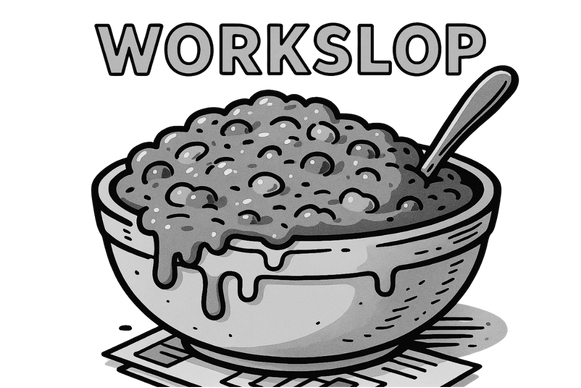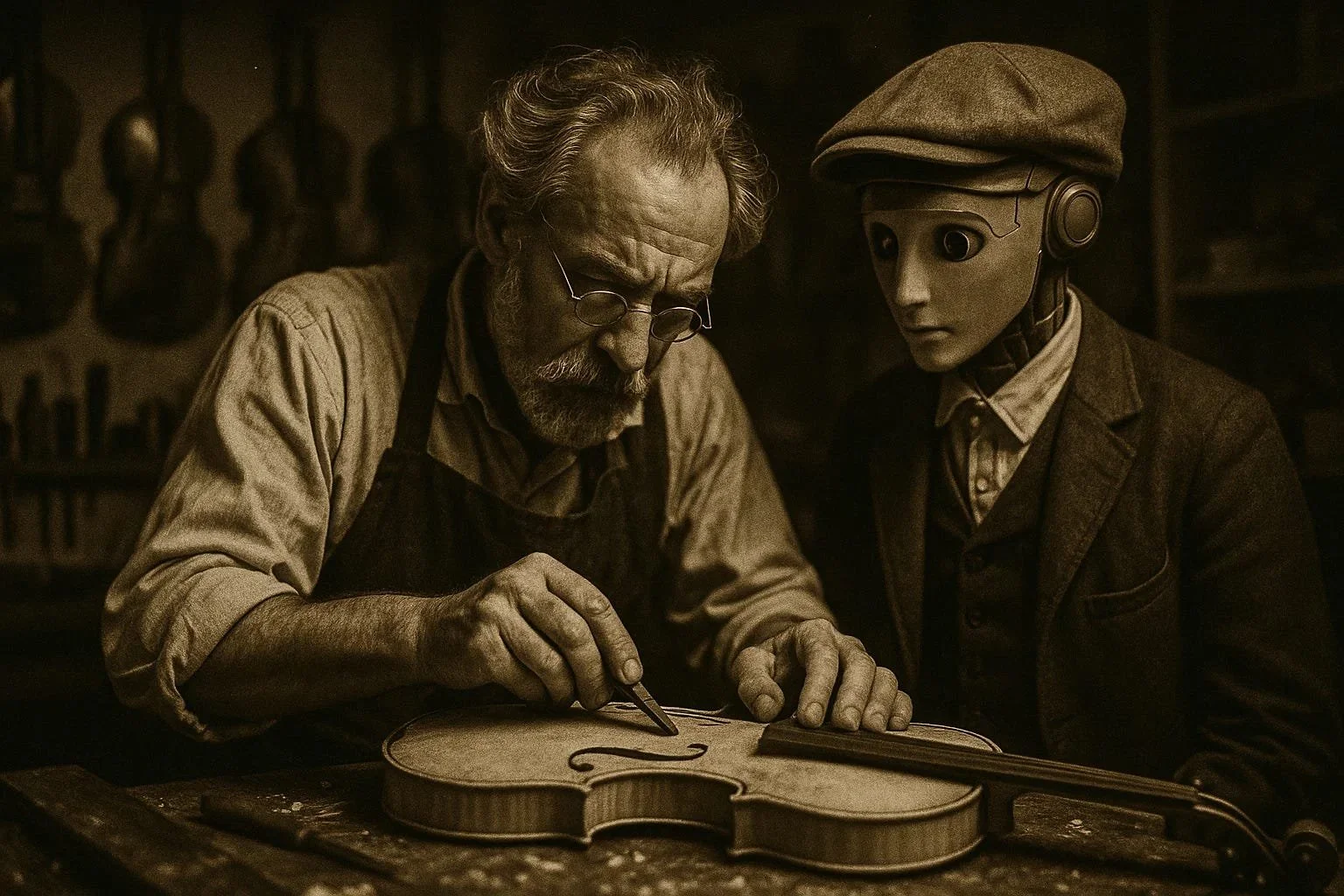Craft is Your Only Moat in the Age of AI
You’ve noticed it in the Monday morning review: your team ships three times faster than last quarter, but you’re rewriting more than you used to. The deck looks polished, the copy reads smooth, but something’s missing. It could be anyone’s work. It could be everyone’s work. Your SVP praised the “velocity.” You nodded. Then you spent Sunday night fixing what should have been ready Friday.
The problem has been named
Here’s what’s actually happening: AI hasn’t made your team better at their craft. It’s made them faster at producing work that looks like craft. Those are not the same thing. And if you’re not naming that gap with your team, you’re accidentally rewarding speed while eroding the capability you need most. Because craft is a competitive moat in the always-on, sped-up, copy-paste age of AI.
Craft might sound artisanal and old-fashioned. But it isn’t about rejecting technology or romanticizing the analog. It’s the disciplined application of judgment to produce work that meets a meaningful standard. It’s knowing what good looks like, understanding your tools deeply enough to use them judiciously, and having the conviction to say “not yet” when something isn’t ready. It applies as much to strategy consulting and software engineering as it does to furniture making. AI can’t supply craft — but it can multiply it.
The uncomfortable truth? Most organizations are accidentally training their people to outsource the one thing AI can’t do: judgment. When your designer prompts Midjourney without knowing what makes a layout work, when your analyst feeds ChatGPT a question without checking if the framing is sound, when your consultant ships the first draft because “it’s good enough and we’re moving fast” — they’re not learning to use a tool. They’re learning to delegate taste.
Why This Feels Different Than Every Other Tool Shift
I’ve spent over twenty years watching teams adopt new capabilities — from design systems to data platforms. The pattern is usually: initial resistance, messy adoption, eventual integration, net improvement. But AI is breaking that pattern in a specific way.
Previous tools made execution easier. AI makes output easier. It skips the part where your people develop judgment about what’s worth making in the first place. A junior designer used to produce three concepts in a week and learn from critiquing which worked and why. Now they produce thirty concepts in a day and learn… what? How to prompt better? Maybe. How to evaluate quality? Unlikely. The feedback loop that builds taste has been short-circuited.
This problem is compounded by a timing collision most leaders haven’t fully processed: the Cambrian explosion of AI arrived just as hybrid work fractured the traditional apprenticeship model. The over-the-shoulder critique, the whiteboard wrestle, the “let me show you what I’m seeing in this draft” — those taste-building moments were already harder to create. Now your junior people can produce thirty polished artifacts from their home office without anyone seeing their thought process, their false starts, their calibration conversations. They’re learning to prompt in isolation instead of developing judgment in community. The capability gap isn’t just about AI. It’s about AI arriving at the exact moment when the informal teaching infrastructure broke.
I saw this crystallize last month while coaching a corporate strategy team. Brilliant people, strong pedigree, good intent. They’d used the company-approved AI tooling to draft a recommendation deck for a board meeting. The output was coherent, well-formatted, and thoroughly researched. It was also generic in a way I couldn’t initially name.
Then I asked: “What’s the one decision this deck needs the board to make?”
Silence.
“What’s the main objection you’ll hear in the room?”
More silence.
They’d optimized for producing a deck. They’d skipped the thinking that makes a deck matter. AI had scaled their output while shrinking their judgment muscle. The tool wasn’t the problem. The absence of a compass was.
A mental model: Compass x Flywheel
Here’s the framework I now use with every team navigating this transition:
Your Compass: Intent, taste, judgment, standards — the timeless fundamentals that determine “where and why”
Your Flywheel: Speed, scale, systematic leverage — the technical skills and capabilities that determine “how fast and how far”
This isn’t additive. It’s multiplicative. Which means if your compass is weak, AI just helps you go faster in the wrong direction. A zero compass multiplied by infinite AI throughput still equals zero impact.
But — and this is crucial — a strong compass without a flywheel is equally limiting. Picture two luthiers, both with extraordinary ears and exacting technique. One shapes every curve by hand, producing beautiful instruments that nearly bankrupt the calendar. The other has the same taste but adds jigs, CNC assists, templates, and systematic finishing protocols. Same wood shavings, same shellac, more consistently excellent instruments at scale.
The difference isn’t talent. It’s leverage. The first is Compass-only. The second is Compass × Flywheel.
Your job as a leader isn’t to slow down the flywheel or resist AI adoption. It’s to ensure the compass stays true while the flywheel accelerates. Most leaders are doing the opposite: celebrating velocity while the compass drifts.
The Timeless Fundamentals (Your Compass)
These are the capabilities that made great work before AI and will still matter when we all have neural links implanted. You cannot delegate these to AI without outsourcing your advantage:
1. Focus
Can you state — for every project — for whom, to create what outcome, by changing what behavior, under what constraints? Not “make a dashboard.” Instead: “Help regional managers spot margin compression early, so they escalate before it’s a crisis, using only data they already trust.”
I watch teams skip this step constantly now. They jump straight to prompting. The AI gives them something, so they ship it. But “something” that’s well-executed in the wrong direction is worse than nothing — it’s a costly distraction dressed up as progress.
2. Framing
Build arguments, not just artifacts. Before you produce the deck, the prototype, the report, the campaign — can you articulate the stakes, the trade-offs, the expected outcomes? Could you explain your reasoning to an intern? To your boss? To yourself six months from now?
AI is exceptional at producing artifacts. It’s incapable of knowing whether the artifact matters. That’s the human job. When you lose the habit of framing — of thinking through why this, why now, what’s at risk if we’re wrong —you become a prompt engineer instead of the steward of high-quality outcomes.
3. Feedback
Develop rituals for critique that improve work without flattening it. This is where taste gets sharpened. But here’s what I’m seeing: teams generate ten AI variations, pick one based on vibe, and ship it. The iteration happens in the prompt, not in the judgment.
Real feedback requires specificity: “This layout buries the call-to-action” beats “Make it pop.” “This logic jump will lose the CFO” beats “needs work.” Your team needs practice giving and receiving this kind of input. AI can generate variations endlessly, but it can’t tell them which variation solves the actual problem.
4. Fit and Finish
Turn personal judgment into shareable standards. What does “done” mean? Not “AI said it’s complete,” but your actual definition: Is it readable for our audience? Accessible? On-brand? Ethically sound? Strategically coherent?
I worked with a team that shipped a client presentation with a beautiful AI-generated chart that, upon closer inspection, included impossible data relationships. No one caught it because “the AI made it, so it’s probably right.” The absence of a finish standard — of someone saying “not good enough” — let flawed work escape.
This is the capability decay I worry about most: teams losing the muscle to say “no, redo it” because the output looks professional enough and they’re rewarded for speed and/or volume.
The Multipliers (Your Flywheel)
Once your compass is calibrated, AI becomes genuinely powerful. These are the capabilities that convert taste into throughput:
Search & Synthesis: Instantly recall patterns, precedents, constraints. Compress messy inputs into crisp options and narratives.
Simulation & Suggestion: Preview “what-ifs” cheaply before spending real resources. Generate volume ideation — variations, alternatives, edge cases — without depleting your creative energy.
Scaffolding: Kill blank-page paralysis with drafts, templates, and outlines that give your team something to react to and improve.
Standardization & Scoring: Automate compliance with brand rules, accessibility standards, structural heuristics (clarity, tone, logic). Free your team’s attention for higher-order decisions.
Stitching & Serialization: Orchestrate tools into smooth pipelines. Turn one-off wins into reusable prompts, playbooks, patterns.
Segmentation: Personalize at scale so the same core message or offering resonates differently for different audiences.
The mistake most teams make is that they adopt these multipliers without first strengthening their compass. They get really good at producing more mediocrity, faster. Then they wonder why their team feels less capable despite being more productive.
There’s a quiet anxiety that systematizing craft will strip its soul. The opposite is more common: we drown the soul in logistics — versioning, formatting, compliance, handoffs — and arrive too depleted to make the brave choices that matter. AI’s best gift isn’t speed. It’s cutting the taste tax — the friction that used to consume the energy you need for exploration, iteration, and exercising your judgment.
Practicing your craft in the Age of AI requires you to masterfully apply timeless fundamental and new capabilities that help you produce quality at unprecedented speed and scale
What This Looks Like in Practice
Let me show you two teams applying Compass × Flywheel:
1) The Design Team That Outran Their Calendar
A product design squad was tasked with reimagining their onboarding flow. Historically: two weeks on stakeholder interviews, two weeks on concepts, then multiple rounds of vague feedback (“Can you just… make it pop?”). Timeline: six sprints. Morale: low.
Compass moves:
They started by writing a two-sentence design intent and a short list of non-negotiables: “Reduce time-to-first-value. De-risk unfamiliar steps visually. Make recovery obvious.” They identified five benchmark flows — not to copy, but to anchor their taste. This took three hours. It saved three weeks.
Flywheel moves:
AI consolidated interview notes into pain patterns and opportunity statements
They prompted for twelve onboarding variations, each with rationale, and simulated drop-off hotspots (“Where would a confused user bail?”)
AI scored flows for clarity, accessibility, and tone consistency
The strongest patterns became reusable “onboarding blocks” labeled by outcome (“Reduce anxiety,” “Clarify next step”)
They tailored blocks for three user archetypes without starting over
Result:
One week. Three polished options with embedded rationales. Stakeholders reacted to clear choices instead of vague concepts. Shipped in sprint three, not sprint six. The team spent their energy on the irreducible work: defining intent, making trade-offs, telling a coherent story.
The craft felt more human, not less, because they spent time on judgment instead of logistics.
2) The High-Stakes Presentation That Didn’t Require Heroics
A consulting team needed an executive deck for a high-stakes decision. Smart people, exhausted people, allergic to generic strategy theater.
Compass moves:
The engagement lead wrote a one-paragraph “Decision Script”: the single decision the client must make, the three reasons why, and the one counterargument they will likely hear in the room. Then sketched a backbone narrative (Act I: Why change, Act II: Options and trade-offs, Act III: The decision and day-one plan). This clarity set direction on tone, stakes, and story spine.
Flywheel moves:
AI drafted a storyboard with slide purposes, not just titles (“Goal of this slide: flip risk perception by reframing status quo costs”)
For each key claim, AI proposed three visual framings (before/after, waterfall, decision tree) with trade-offs
It converted their rough draft into brand-compliant layouts
It flagged jargon density, passive voice, and suggested tighter verbs
It assembled a meeting kit: deck, speaker notes, one-page leave-behind, email summary
Result:
The team shifted from “move boxes around until 2 a.m.” to “tighten logic and rehearse delivery.” The final product was persuasive because the argument was clear, not because the kerning was perfect (though that helped). AI eliminated busywork that used to tax taste. Human energy stayed where craft actually lives: storyline, trade-offs, credibility.
Three Coaching Principles to Hone Your Craft for the Age of AI
Aim, then accelerate.
If intent is fuzzy, AI scales mediocrity. Make your team slow down to aim first. Before they prompt, they should answer: For whom, to create what outcome, by changing what behavior, under what constraints. Fuzzy intent × fast AI = expensive garbage. Or, in the words of Peter Drucker, “There is nothing so useless as doing efficiently that which should not be done at all.”Build a pattern library.
When your team makes a good decision, codify it. “When the goal is X and the audience is Y, we prefer pattern Z because…” This isn’t about killing creativity. It’s about not re-litigating settled questions. Let them spend creative energy on the problems that actually need solving.Instrument your guardrails.
Create examples of excellent work and rubrics that reflect your standards: clarity, accessibility, brand fit, and narrative structure. Let AI run the checks so your team focuses on higher-order judgment. Don’t make them manually verify things machines can verify. Make them think about things machines can’t.
The Contrarian Bet
Here’s what most leaders are missing: the companies investing most aggressively in AI tools are often getting the worst returns. Not because the tools are bad, but because they skipped the step of clarifying intent and strengthening taste first.
They celebrated the designer who produced fifty concepts in a day without asking if any were good. They rewarded the analyst who delivered the report in half the time without checking if it answered the right question. They scaled output while shrinking judgment.
Your competitors are making this mistake right now. They’re training their teams to prompt, not to think. To produce, not to evaluate. To ship fast, not to ship right. “Workslop” is an epidemic eroding productivity and trust.
This is your window.
The teams that win in the next few years won’t be the ones with the most AI adoption. They’ll be the ones who kept their compass sharp while everyone else optimized for flywheel speed. They’ll be the ones whose people can still tell good from bad, important from urgent, signal from slop.
AI doesn’t have taste. It has throughput. Throughput is only valuable when taste points it somewhere worth going.
Your job isn’t to slow your team down. It’s to make sure that when they accelerate, they’re aimed at something that matters. Keep the compass true. Build a bigger flywheel. Then let your taste travel.



